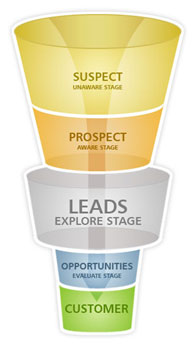A New Generation of Lead Creation: Defining the Sales Funnel
By Glenn Renner
HomeSphere President & COO
Originally Published in Residential Building Products & Technology
At HomeSphere, we have a unique perspective on the residential construction industry. We work with the nation’s largest collection of home builders, contractors, distributors and building product manufacturers (BPMs); but we don’t sell homes, home improvement services or building products. We sell connections—to all points of the distribution channel—and open up the lines of communication from BPMs all the way to the end consumer. Our sales teams are out in the field each day with manufacturer reps and home builders who freely share valuable industry insight because we aren’t in competition with them, but rather here to benefit all parties involved in the homebuilding process.
Therefore, we believe we are distinctively qualified to provide knowledge and share best practices with the readers of Residential Building Products and Technology. Each month we’ll build upon previous articles to enhance your sales and marketing efforts and ultimately close more business.
The Changing Nature of Sales
Generating a true sales opportunity is difficult during good times. A depressed housing market only magnifies the challenge. Further compounding this challenge is the changing nature of sales. Lead generation has morphed from traditional cold calling or feet-on-the-street selling to digital demand generation, leaving companies to re-craft their sales and marketing functions.
Where Sales Opportunities Lie
In years past, sales departments were ultimately responsible for lead generation, nurturing and closing business. Marketing departments were often on the sideline generating sales sheets, attending events, or placing broad advertisements, all with little to no measurable data to indicate effectiveness. Today, the paradigm has shifted. The ability to target a prospect directly using web-based tools has changed the entire landscape of sales and marketing with notable examples in such companies as TD Ameritrade, General Motors, Allstate Insurance and The University of Phoenix.
Now is the time for companies in the building products and construction industry to increase efficiency in sales and marketing through the use of digital advertising and lead generation.
 Change the Language, Change the Culture
Change the Language, Change the Culture
If companies change their vocabulary when talking about their sales process, they’ll change their culture… and their revenue. Historically, the sales process began with a “lead,” usually found through static advertisements or the cold-calling efforts of a sales professional. We coach our customers to back up slightly and define the sales funnel:
• Understand your Suspects
Before identifying a potential customer as a lead, we define the individual’s understanding of the company’s brand. In this new culture, a potential customer who is unaware of your products or services is called a “suspect.” In today’s marketplace, these suspects can be generated by new techniques which we’ll describe in depth in future articles.
• Identify your Prospects
Next in the sales funnel is a “prospect.” Prospects are aware of the brand but do not yet know how to engage as a customer –how to use the brand. Prospects need to explore; they need to learn more about a company’s benefits and how the company distinguishes itself from the competition. Online sales & marketing programs can be invaluable to determining who your prospects are and how you can drive them to the lead stage.
• Educate your Leads
During this exploration process, the potential customer becomes a true “lead.” It is at this point that the marketing team can build a relationship using digital marketing techniques with the goal of earning their business when the time is right.
• Create Opportunities
With the help of ongoing nurturing campaigns incorporated with lead scoring, the lead can become an opportunity for personal sales follow-up and, finally, a customer acquisition.
Understanding that the sales funnel starts well before the lead stage is critical to aligning marketing with sales and to taking advantage of the power of the new digital marketplace. Armed with this new language, companies can start the work of changing the organization’s sales and marketing structure. Next month we’ll explore these roles and the responsibility each department has during the sales process.



